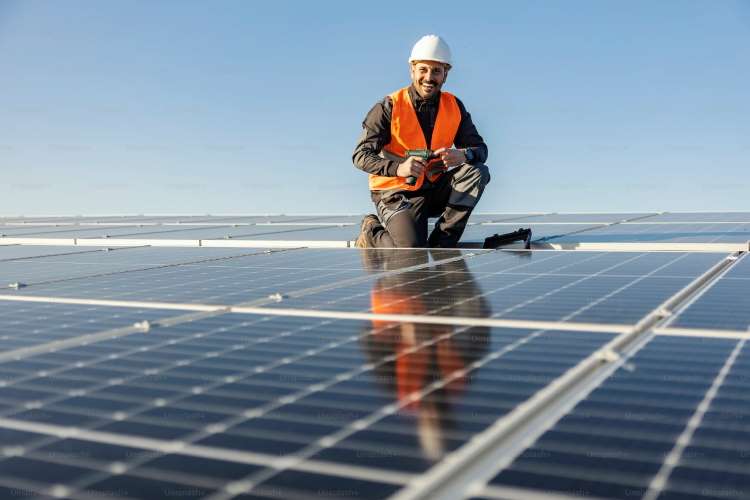In recent years, India has witnessed a remarkable transformation in its energy mix, driven by a growing commitment to harnessing renewable sources. One of the standout success stories is the rapid expansion of rooftop solar energy systems across the country. India has made some rapid strides in rooftop solar sector, enabled by the policy and financial environment provided by the government to tap the immense potential of this clean and sustainable energy source.
India’s rooftop solar potential is nothing short of impressive. With over 25 crore households capable of deploying 637 GW of solar energy capacity on their rooftops, the scope for clean energy generation is enormous. However, realizing this potential comes with its own set of challenges.
READ | India bets on credit offtake boom, balancing growth with prudent risks
Awareness and willingness to embrace rooftop solar systems also play a pivotal role. A CEEW report found that awareness levels among residential consumers were below 50%, with many perceiving rooftop solar systems as costly investments. To bridge this gap, targeted awareness campaigns, coupled with attractive incentives, can stimulate consumer interest and drive market growth.
Beyond affordability, advancements in panel efficiency, micro-inverters, and smart monitoring systems are making solar installations even more attractive. Imagine capturing more sunshine from smaller panels, maximizing output with individual panel tracking, and conveniently overseeing your energy generation through a smartphone app. These innovations are not just technological feats, they’re paving the way for a future where every rooftop becomes a mini power plant, humming with clean, independent energy.
The government has been a strong supporter of rooftop solar energy, recognising its potential to meet part of the country’s growing energy demand while reducing carbon emissions. To encourage adoption, the government has implemented a series of policies and financial incentives aimed at making rooftop solar systems more accessible and affordable to both residential and commercial consumers.
One crucial aspect is the economic feasibility of rooftop solar for residential consumers. The majority of residential consumers fall into low-consumption categories, and without financial support, solar installations may not be viable for them. To address this issue, the ministry of new and renewable energy has provided capital subsidies, which significantly expand the potential for rooftop solar adoption.
The rooftop solar movement is diversifying its financial options. Leasing models allow you to enjoy the benefits of solar power without upfront costs, while Power Purchase Agreements (PPAs) let you pay for the electricity generated, not the panels themselves. And for those who fall through the cracks of standard financing, green loans or community solar initiatives are emerging as beacons of hope, ensuring that everyone has a path to participate in the rooftop solar revolution.
Govt support crucial for rooftop solar projects
Recently, the Union government had increased the financial assistance for systems with capacities ranging from 3 kW to 10 kW. This will incentivise consumers to invest in larger rooftop solar installations, driving the adoption of cleaner energy sources.
Another significant development is the introduction of the ‘distributed renewable energy’ segment in renewable purchase obligations. Under these revised obligations, power distribution companies are mandated to purchase renewable energy from rooftop solar projects. This requirement not only promotes the growth of rooftop solar but also ensures a stable market for clean energy.
Imagine millions of mini power plants feeding electricity into the grid. Managing this dance of electrons requires a skilled partner: intelligent grid integration. Net-metering policies, where excess solar power earns credits against your electricity bill, are encouraging this partnership. Research into smarter grids and balancing mechanisms is also underway, ensuring that the sun’s bounty gets seamlessly woven into the fabric of our energy infrastructure.
Challenges and solutions
Despite the remarkable progress, challenges persist in the rooftop solar sector. Delays in project implementation and negotiations, as seen in the case of Chandigarh, can hinder the adoption of free rooftop solar plants. It’s imperative that such hurdles are swiftly addressed to maintain momentum and meet renewable energy targets.
Furthermore, rural areas hold tremendous potential for rooftop solar, offering higher technical capacity compared to urban areas. Recognizing this potential and ensuring equitable access to renewable energy is vital in India’s quest for sustainable development.
India’s rooftop solar revolution is an example of the country’s commitment to a sustainable energy future. With government support, financial incentives, and increased awareness, the nation is steadily moving towards harnessing the full potential of rooftop solar energy. As the world grapples with the challenges of climate change, India’s progress in this sector stands as a beacon of hope, demonstrating that a clean and green energy future is both attainable and essential.
Rooftop solar isn’t just about sunshine, it’s about opportunity. Installing, maintaining, and managing these mini power plants requires a skilled workforce. Government initiatives and industry-led programs are stepping up to train technicians and engineers, creating a new wave of clean-energy jobs. As the rooftop solar revolution gains momentum, so too will the demand for skilled professionals, paving the way for a future where powering our homes also empowers our communities.

